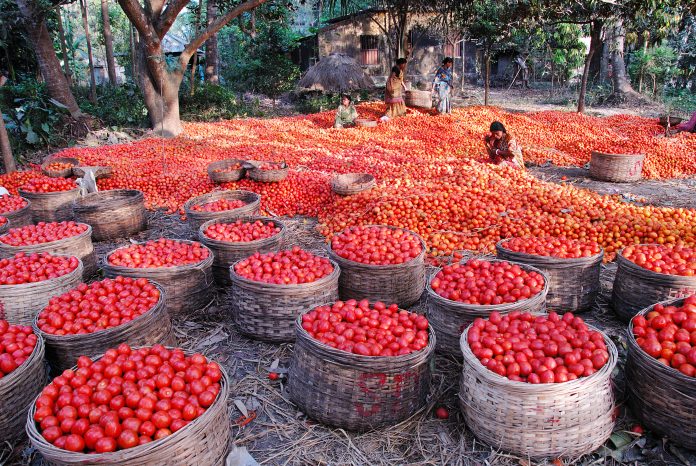Aarthi Janakiraman, Industry Manager, Chemicals and Advanced Materials at TechVision, Frost & Sullivan, discusses advances in plant pathology, with a focus on tomato diseases
Tomatoes are among the economically important vegetable crops grown, with around 200 million tonnes produced globally. While China and India are the largest growers of the vegetable, countries like Morocco, Turkey, European nations such as The Netherlands, Spain, France, Belgium and the U.S. are also prominent.
There are hundreds of varieties of tomato for growers, the choice depending on varying preferences including taste, texture, colour, size and bush type to name a few. Many growers prefer to grow two or more varieties of tomatoes, including at least one heirloom varieties mainly due to the breed’s popularity and suitability to UK’s climate. However, the flavour-rich heirloom tomatoes are often susceptible to diseases many of the commercially available disease-resistant varieties are not characterised by a rich flavour.
Tomatoes generally grow well in a moderately well-drained soil type and various biotic and abiotic factors influence its production and yield apart from physiological factors such as wind patterns, temperature, humidity and inherent varietal resistance, often resulting in blossom-end rot, fruit cracks and uneven ripening. These physiological conditions also play an important role in ensuring productivity and yield.
The most common problems for the crop are caused by low temperatures, over-watering or wet weather. Therefore, it is important to ensure good aeration, water drainage, light and proper nutritional balance of the soil. Judicious use of herbicides is also necessary to avoid curling, stunted growth, discolouration of leaves, strapping etc.
Identification and control of infectious diseases in tomato
Infectious diseases reduce yield and affect produce quality, the most common categories being wilts, leaf spots/blights, fruit spots and rots. Most of the pathogens are fungal in origin with bacterial- and viral-borne infections close behinds with symptoms varying with the host. However, there are certain definitive symptoms that help in the positive identification of the target pathogen.
For example, the presence of a yellow halo surrounding a tan to the dark brown lesion is an indication of bacterial infection despite the symptom being absent when bacterial spots and blights occur.
Fungal blight (especially late blight) is considered as one of the deadly diseases that can affect tomatoes and its impact is devastating just like it is in potatoes and other crops.
Viruses are highly infectious and readily transmitted by any means; cause different symptoms on tomato and may appear as light and dark green mottling of the leaves. For example, tobacco mosaic virus (TMV) causes mottling of older leaves and may cause the malformation of leaflets, which may become shoestring-like in shape. Certain symptoms of viral infections are characterised by leaf mottling, curling, stem and petiole streaking, spotted fruit and stunted plants; these symptoms can sometimes be confused with herbicide damage.
Therefore, it is imperative for proper identification and understanding of the disease agent and its ability, determining if it’s infectious or not, to devise and implement proper control and corrective measures.
The use of disease-resistant varieties, certified disease-free seeds, crop rotation practices, sequential planting, sanitation (removal of crop debris) and ensuring proper nutrition, aeration and drainage can to a certain extent, prevent the occurrence of diseases; however, integrated preventive and control measures are still important to ensure product quality and yield.
European Union (EU) regulations have reduced the availability of chemical control measures and the current measures, while effective during early stages of the disease are often unsuccessful at later stages, especially for diseases such as late blight and result in the destruction of crops, without any effective ways to control the spread of the disease.
Therefore, the selection of disease-resistant varieties has become one of the widely adopted methods to prevent diseases. Despite its success, it cannot be an effective alternative for integrated pest management (IPM) measures and integrated glasshouse management (IGM) in case of cultivation in more controlled glasshouse and indoor environment.
To successfully implement IPM, it’s critical to understand the interactions between plants, environmental conditions, disease-causing agents and its effect on growth, yield and quality; continuing advances in plant pathology studies makes it feasible and can help achieve positive results in disease prevention and control.
Research advances in plant pathology: Need of the hour
While plants inherently develop ways to resist and deal with pathogenic attacks, it’s also common that pathogens are becoming more resistant to control measures and counterattack the plants defence mechanisms.
Therefore, the earlier approach of studying only the influence of biotic factors on plant growth is no longer relevant. Pathology studies are increasingly focusing on molecular and gene-level interactions of pathogens and plants rather than only morphological and physiological influences. Varying approaches for disease management and prevention are being researched, ranging from encapsulating nanoparticles of HarpinPss to improve disease resistance, use of growth-promoting agents to enhance biological resistance of diseases, use of gene silencing techniques for improved resistance and combat diseases, apart from a continuing focus on developing biological plant protection aids.
Researchers are also set to develop high-throughput diagnostic technologies, based on nano-sequencing techniques. The possible use of deep learning platforms and neural networks for real-time detection of tomato plant diseases and pests are also being investigated.
Despite various initiatives, there are still significant gaps in research that can result in the development of fool-proof ways to monitor for potential attacks, scan and monitor for the possible onset of new diseases. There is also a need for initiatives that can help in contingency planning to prevent potential vulnerabilities and future threats. Studies on integrated approaches that can lead to efficient and sustainable cultivation, harvesting and post-harvesting techniques are needed to ensure nutritional quality and microbiological integrity of tomato produce.
This can be achieved only through collaborative and joint efforts of all stakeholders, ranging from growers associations to academia and private companies. With consumer requirements towards “clean-label” and high-quality produce at an all-time high, it is important that key stakeholders focus on research, development and implementation of techniques that can not only ensure yield and profitability but also guarantee the nutritive value and quality as demanded by the end-consumers.
Acknowledgement
I thank the TechVision Group at Frost & Sullivan who helped in providing insights for this article.
References
• https://hgic.clemson.edu/factsheet/tomato-diseases-disorders/
• https://articles.extension.org/pages/72678/late-blight-management-in-tomato-with-resistant-varieties#.VRlDOCvF98F
• Fuentes, Alvaro F et al. “High-Performance Deep Neural Network-Based Tomato Plant Diseases and Pests Diagnosis System With Refinement Filter Bank.” Frontiers in plant science vol. 9 1162. 29 Aug. 2018, doi:10.3389/fpls.2018.01162.
• Chalupowicz, L. , Dombrovsky, A. , Gaba, V. , Luria, N. , Reuven, M. , Beerman, A. , Lachman, O. , Dror, O. , Nissan, G. and Manulis‐Sasson, S. (2019), Diagnosis of plant diseases using the Nanopore sequencing platform. Plant Pathol, 68: 229-238. doi:10.1111/ppa.12957.
• Sandhya Rani Nadendla, T. Swaroopa Rani, Papa Rao Vaikuntapu, Rajesh Rao Maddu, Appa Rao Podile, HarpinPss encapsulation in chitosan nanoparticles for improved bioavailability and disease resistance in tomato,Carbohydrate Polymers,Volume 199,2018,Pages 11-19,ISSN 0144-8617, https://doi.org/10.1016/j.carbpol.2018.06.094.











